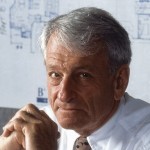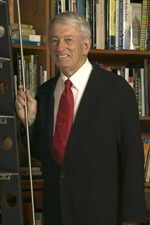Barry Alan Berkus, 77, of Santa Barbara, internationally renowned architect, long at the forefront of residential design in the U.S. and abroad, died Friday, November 30, at Serenity House, surrounded by family. A private memorial service will be held at a later date.

Berkus, known for his innovative approach, designed more than 600,000 residences. Based in Santa Barbara for over 30 years, his architectural team had offices in New York; Los Angeles; Irvine; Sun Valley, Idaho; San Francisco; Chicago; Atlanta; Washington, D.C.; Miami; Kuala Lumpur; and Tokyo.
A lifelong participant in adventure sports, he set world records in hydroplaning, ranked third nationally in 500-mile open water racing, and summited and skied Mt. Vaughan in Antarctica for the very first time. He subsequently became a member of the exclusive New York Explorers Club.
An avid art collector, his extensive art collection included paintings by some of the leading contemporary artists in the world, such as Andy Warhol, Roy Lichtenstein, James Rosenquist, Robert Rauschenberg, David Hockney, Robert Therrien, and Frank Stella. He supported local artists and donated a large body of work to Santa Barbara County, exhibits which continue to travel throughout the county. He has co-chaired the Collectors Committee of the National Gallery of Art in Washington, D.C. since 2009.
A man of immense generosity, he was the longest-living member of the UCSB Foundation Board and has served on many other boards including the Granada Theatre, the Santa Barbara Maritime Museum, and the Wildling Art Museum. He designed the UCSB Mosher Alumni House and helped guide the reconstruction of the Granada Theatre. His designs for the Children’s Museum, to be built on lower State Street, have been approved by the City of Santa Barbara.
He held a Sunday morning basketball game for many years at his home in Hope Ranch, where he once hosted the L.A. Lakers. The “Berkus Boys” still play every Sunday morning in Santa Barbara. He also bicycled every Saturday morning, rain or shine, with the West Las Palmas Association, a group of his close friends, for well over thirty years.
Berkus came to Santa Barbara as a student in 1958, attended UCSB, and later entered USC’s architecture program before pursuing his passion for housing design. He was instrumental in promoting and advancing the role of architect as planner and designer of neighborhoods and communities, redefining living patterns in housing. His resort and master-planned communities, urban infill, commercial and institutional projects, and custom homes have earned his design team more than 300 design and planning awards from regional, national, and international competitions over the past 40 years.

Architectural Digest named him one of the world’s “top 100 architects” in 1991. Professional Builder honored him as the most innovative architect in the area of housing in the United States. The readers of Residential Architect selected Berkus as one of the ten most significant figures of 20th Century residential architecture. In 1999, Builder magazine counted Berkus as one of the 100 most influential individuals in the past century of American housing.
He authored several books including Architecture, Art, Parallels, Connections, a book which examines basic design principles as they are revealed in works of art and relates these principles to both the built and unbuilt environment. House Design, Barry A. Berkus, Sculpting Space, released in 2002, offers a diverse sampling of the many Berkus-designed custom homes.
His influence was not limited to domestic architecture in the United States. His interest in building systems spearheaded extensive research and development of modular housing and the study of building methods abroad. In Japan, his work extended from the planning and design of new towns to the development of the current building codes for framed construction. Other international projects included the planning of communities in Malaysia, master planning of residential villages for Euro Disney in France, and the redevelopment of the waterfront Expo site in Vancouver, British Columbia.
Lecturing frequently in Asia, Europe, and throughout the United States, he was the keynote speaker for the 25th anniversary of Weyerhaeuser in Japan and a featured speaker at the 50th anniversary of the Urban Land Institute. He served on a subcommittee of the National Academy of Science — reviewing the certification of building technology — and a subpanel of the National Institute of Building Sciences. He also served on the Policy Advisory Board for Harvard University’s Joint Center for Housing Studies and was a member of the American Institute of Architects and the Urban Land Institute. In 2005, he was inducted into the Builder’s Choice Hall of Fame.
In 1984, his teams designed, supervised construction, and built a temporary village for Olympic athlete housing at Lake Casitas and served as the commissioner of rowing for the 1984 games. One of the greatest pleasures of his life was the fact that, throughout his architectural practice, he mentored many young architects just beginning their careers, many of whom have gone on to open their own offices throughout the country.
Born in Los Angeles on November 25, 1935, he grew up in Pasadena, meeting and marrying his high school girlfriend, Gail Hanks in 1957. Gail died in 2000. He married Jo Cahow in 2005, who has been a loving and caring wife. He is survived, as well, by his two sons and their wives, Jeffrey and Rebecca Berkus of Aspen, Colorado, Steven and Dana Berkus, and his daughter, Carey Berkus, currently a resident of San Miguel de Allende in Mexico. Also surviving are his four grandchildren: Sarah, Kelson, Renae and Stuart Berkus, his brother, David Berkus and wife, Cathy, of Pasadena.
The Berkus family extended gratitude to Dr. Tom Woliver, Dr. Jeffrey Kupperman, Dr. Gary Van deVenter, Carmen Flores, Barbara Pell, RN, OCN, Hospice Case Manager, many friends, and others for their compassionate care during his illness. In lieu of flowers, donations in his memory may be made to Visiting Nurse and Hospice Care, Hospice of Santa Barbara, the Granada Theatre and the Santa Barbara Maritime Museum.
